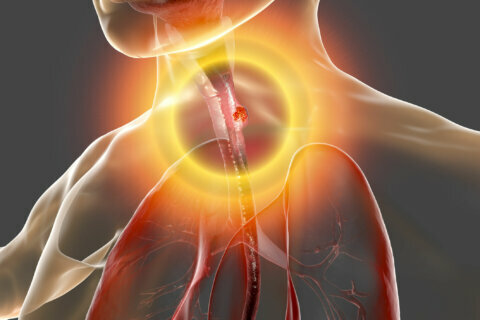Respiratory viruses are common in children under 5, particularly those who attend daycare or are exposed to tobacco smoke. Most cases are mild, but for some children, an ordinary cold or flu can quickly turn into asthma, RSV or pneumonia that requires ER treatment or hospitalization.
Here’s how it happens:
What Symptoms Should You Watch for in Your Child?
Contact your child’s doctor if common cold symptoms are complicated by any of the following:
— The child is younger than 3 months.
— The child has ever been diagnosed with asthma or reactive airways disease.
— The child has a fever above 100.4 degrees Fahrenheit in babies under 3 months old; above 101 degrees in babies 3 to 6 months; or above 102 degrees in babies older than 6 months.
— Daytime cough or cold symptoms last for more than 10 days.
— Cold symptoms come back a day or two after they seem to go away.
— The child tugs at an ear and develops an earache.
— Blue lips or face due to difficulty breathing.
Call 911 or take your child to the emergency room for any of these symptoms:
— Wheezing (noisy breathing when exhaling).
— Signs of trouble breathing: nostrils widening with each breath; rapid breathing; skin above or below the ribs sucking in with each breath; skin, lips or nails turning blue.
— A severe headache behind or around the eyes or the back of the neck; swelling or redness around the eyes.
— Persistent vomiting or signs of dehydration: dry or sticky mouth; few or no tears; thirst; discolored or less urine than usual.
RSV — Respiratory Syncytial Virus
RSV is a common respiratory virus. By the time children are 2 or 3 years old, most have been infected by RSV at least once, with few problems. However, for some, the virus can be life-threatening — and the infection sends more babies to the hospital than any other condition.
High-risk groups include:
— Babies less than one year who were born prematurely.
— Infants under 6 months.
— Children with asthma or reactive airways disease.
— Patients of any age with underlying lung, heart or immune system problems. This includes cancer and transplant patients.
RSV tends to occur and spread in the winter and early spring. It starts as an upper respiratory infection, with familiar cold symptoms. What makes it so dangerous is its ability to quickly spread down from the nose and throat into the lower respiratory tract, where it infects and causes inflammation in the tissues of the lungs (causing pneumonia) and the tiny bronchial air tubes (causing bronchiolitis).
Inflammation is the body’s natural process for fighting infection, but in tiny infant airways or those already inflamed by asthma, it can cause increased airway obstruction and difficulty breathing.
Another danger of RSV is that a serious RSV infection in young children increases the child’s risk of developing asthma in later years. Researchers don’t know exactly why this happens. It may be a cause-and-effect reaction, where the RSV infection damages the lung, which leads to asthma; or it may just be an association, where factors that put children at risk for asthma also put them at risk for a more serious RSV infection. RSV and other viruses have also been linked to an increased risk of sensitization to allergens and development of allergies.
RSV is also common among adults, particularly those with weakened immune systems such as people with asthma or COPD, cancer patients, those with either immunodeficiency or autoimmune disease and those in close contact with large numbers of people, like senior citizens living within group settings.
Preventing RSV
The highly contagious virus can live on hard surfaces such as doorknobs and tabletops for days and spreads quickly through human contact, often before the infected person shows any obvious signs of the disease. To help prevent it:
— Wash hands frequently, especially before eating or before handling babies.
— Wash and disinfect toys, tabletops, doorknobs and other shared surfaces.
— Avoid sharing cups, eating utensils or food.
— Avoid people with obvious cold symptoms.
— Avoid cigarette smoke, which can increase the risk of infection and severity of symptoms.
— Don’t let others handle your baby without washing their hands first.
Recognizing RSV Symptoms
Parents and caregivers of children with asthma, premature babies and infants — as well as elderly people — need to take extra precautions during the RSV season, learn to recognize the warning signs and seek medical treatment as soon as possible for any of the following RSV symptoms:
— High fever (or low fever if immunocompromised)
— Rapid breathing or other signs of difficulty breathing
— Wheezing
— Worsening, barking cough
— Skin, lips or nails turn blue
RSV Treatment
There is no medical cure for RSV. Physicians focus instead on treatments that reduce congestion and open the airways so the patient can breathe. Serious cases require hospital care, intravenous fluids, nebulizer medications and oxygen treatments.
Some patients get secondary pneumonia as a result; this needs to be treated aggressively with antibiotics. Some high-risk babies may qualify to receive a preventive medicine called palivizumab, given by injection every month during RSV season. Palivizumab is not a vaccine. Similarly, some transplant patients with severe disease may benefit from adding an antiviral agent — but the primary treatment is supportive care.
Purvi Parikh, MD, is an allergist and immunologist with Allergy & Asthma Network , the leading nonprofit patient education organization for people with allergies, asthma and related conditions. She practices in New York City at Allergy and Asthma Associates of Murray Hill and New York University School of Medicine. She sits on the Board of Directors for the advocacy council of the American College of Allergy, Asthma & Immunology.
More from U.S. News
10 Cold and Flu Myths Debunked
How to Disinfect Germ Hotspots
11 Winter Produce Picks That Pack a Health Wallop
When the Common Cold Turns Serious: How to Recognize RSV and Other Respiratory Infections originally appeared on usnews.com







